The Rise of the Solo Diner
An increasing number of single-person households and business travelers are fueling the call for ‘table for one.’ Here are some insights to attract and serve this growing market.
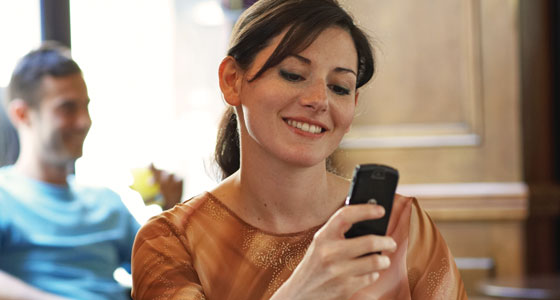
For a kid, there’s perhaps nothing more mortifying than the prospect of eating lunch alone in the school cafeteria. Solo dining in that formative milieu is seen as a sign of weak social standing, not a triumphant statement of individualism (and certainly not an indication of a deep interest in food!). As a culture we’ve long carried these attitudes about the social dimension of eating into our adult lives—the solitary diner at a restaurant was assumed to be lonely and sad, the butt of jokes, and the object of scorn (think of the classic 1984 film The Lonely Guy, where Steve Martin brings an entire bustling restaurant to a screeching halt with his meek request for a table for one).
Our childhood hang-ups about eating alone in public may not be universally resolved (witness the birth of new apps such as DineSocial and Invite For A Bite, designed to find you a dinner companion on the fly). But thankfully, the tide is turning. More and more Americans are choosing to eat in restaurants alone, and are taking great pleasure in doing so. And the restaurant industry is starting to notice.
This trend in solo dining is in line with Americans’ preferences for other leisure activities as well—across the board, people are increasingly interested in relaxing alone. According to market researcher Mintel, 41% of Americans prefer to shop alone, 45% prefer to work out alone, and 73% prefer to cook alone. It seems that while 24/7 connectivity has become a fact of life, our desire for solitude has grown. And interestingly, we tend to enjoy our solitude more in public: A recent study published in the Journal of Consumer Research confirms that we have more fun by ourselves when we get out of the house—a fact that veteran solo diners have long understood, and one that’s catching on with many more people.
At CCD Innovation, we’ve long noted the increasing number of people eating alone, both in our home base of San Francisco, and around the country during our travels. In 2014, we decided to investigate the trend more systematically, and we conducted a national survey to explore the demographics (Figure 1) and causes of this shift. We discovered that more than half of all respondents ate by themselves at least twice a week, with over a quarter dining alone five or more times a week (Figure 2).
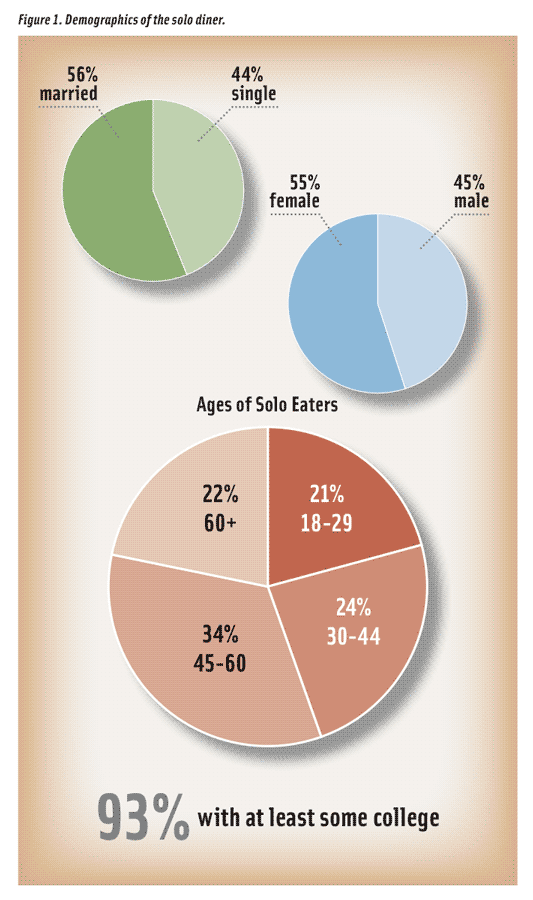
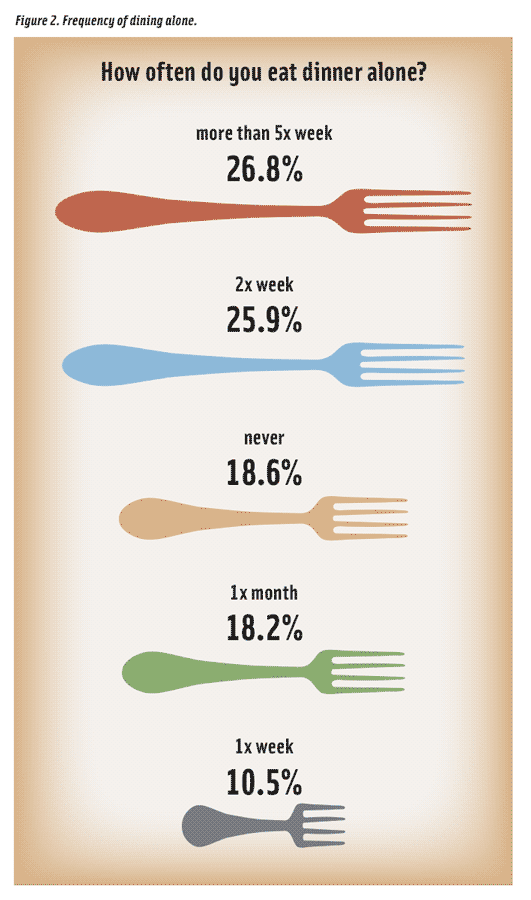 That adds up to a lot of solo suppers. These diners are worth attending to, and not just because their numbers are on the rise. They are by many measures easier and faster to service. And many chefs and restaurant owners see the presence of solo diners as a tip of the hat—a diner who comes to a restaurant alone has made a purposeful choice to spend their time and money at that establishment.
That adds up to a lot of solo suppers. These diners are worth attending to, and not just because their numbers are on the rise. They are by many measures easier and faster to service. And many chefs and restaurant owners see the presence of solo diners as a tip of the hat—a diner who comes to a restaurant alone has made a purposeful choice to spend their time and money at that establishment.
We’ve seen more media and industry focus on this phenomenon in recent months, and restaurants and manufacturers have begun to pay attention to the needs and desires of solo diners. But more can be done to accommodate and attract this growing market.
--- PAGE BREAK ---
Who’s Flying Solo, and Why?
Considering contemporary demographics, it’s no surprise that more of us are requesting tables for one. Single dwellers are now the fastest growing segment of U.S. households, with almost a third of the population living alone, according to the U.S. Census Bureau. And our survey showed that single people eat out more than those who are coupled—singles comprised the majority of those who reported eating out five times a week or more.
A Mintel survey examining single-dweller households found that millennials make up the largest segment of singles, in part because they are waiting longer to marry and have families. And they enjoy their solitude: millennials report spending 43% of their leisure time alone. Younger diners eat alone because they can and they want to.
Boomers and older Americans make up a growing percentage of singles. While some remain single by choice, for many, it’s the result of divorce or death. But regardless of the circumstance, more Boomers (57%) prefer to spend time alone than with company. Add to that the fact that Boomers have money, outspending other generations by about $400 billion per year on consumer goods and services, and it’s no wonder that they are significant drivers of the increase in solo dining.
With the economy again on the rise, business travelers of all ages are also fueling the increase. Significant growth in worldwide expenditures for business travel is expected to continue for the next five years. These travelers need three meals a day when they’re away from home, making them a captive audience for the restaurant industry.
As with business travelers, there will always be people for whom dining alone is a necessity borne of the logistics of their lives, whether they like it or not. But the decreasing cultural stigma around eating alone means that more people feel they have permission to take pleasure in dining solo. Solo diners report a sense of satisfaction and freedom while dining alone; our survey indicated that they prize the peace and quiet of a solitary meal, and the freedom to entertain themselves as they please.
Solo diners also appreciate the chance to choose where to go and what to order without having to share or compromise. Want to start off with the bacon-wrapped dates, move on to the bacon and cheddar burger, and have the bacon truffle ice cream for dessert? When you’re keeping only your own company, there’s no one to gross out but yourself. There’s also no being swayed to the pricier bottle of wine or the appetizer you don’t really want, and for many, the appeal of solo dining also lies in the resulting smaller bill. Moreover, there’s often less of a wait to be seated as a singleton, since peak meal-times see traditional seating fill up faster than bar seating or very small tables.
All of these things are bringing solo diners to restaurants in greater numbers than ever before, with the largest percentage (37%) opting for fast-casual restaurants such as Chipotle and Panera (Figure 3). Fast-food and mid-scale restaurants rank next (16% and 14%, respectively), and fine dining brings up the rear (3%).
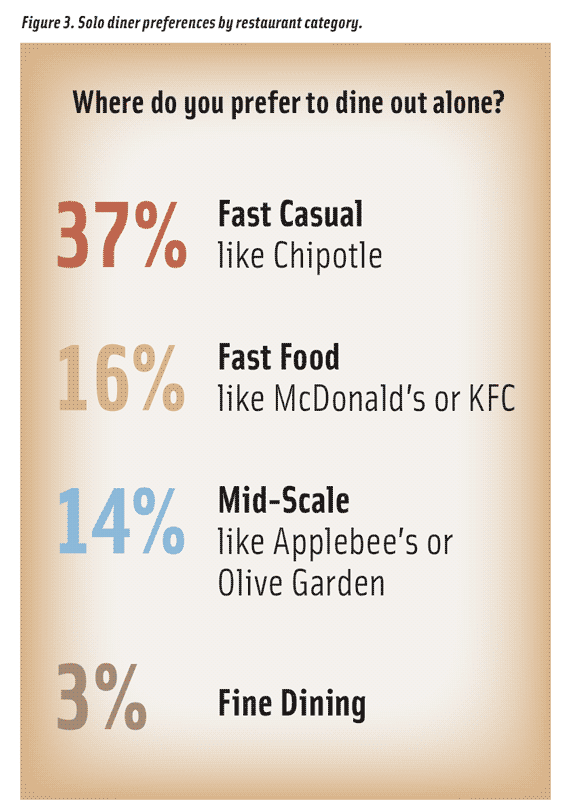 Of course, eating alone isn’t always what we might hope, and survey respondents reported downsides as well: boredom, loneliness, and lack of company and conversation all ranked as parts of the experience that can be negative. So how can restaurant owners and manufacturers capitalize on the positives and address these downsides to make solo dining more attractive? Here are five insights and action items for increasing your appeal to unaccompanied diners.
Of course, eating alone isn’t always what we might hope, and survey respondents reported downsides as well: boredom, loneliness, and lack of company and conversation all ranked as parts of the experience that can be negative. So how can restaurant owners and manufacturers capitalize on the positives and address these downsides to make solo dining more attractive? Here are five insights and action items for increasing your appeal to unaccompanied diners.
1. Celebrate the Soloists. Solo diners like to have options when it comes to seating, service, and menus. Some may seek out conversation with a stranger or their server in a bustling section of the restaurant, while others may be interested only in the companionship of their newspaper, their soup, and a cozy corner. Restaurants should be prepared to accommodate a range of preferences, and manufacturers should consider creative ways to help meet their needs.
2. Think Big About Communal Seating. Bar seating is perennially popular with solo diners—those who are interested in having company can find a like-minded stool-mate, or at least a captive bartender. And diners appreciate that bar menus are often less expensive and service is often faster. From the restaurant perspective, communal seating has the added benefit of being extremely efficient in terms of space and service requirements.
The bar seating at fast-casual and mid-scale restaurants is one element that accounts for their popularity among people eating alone. Mid-scale restaurants in particular tend to attract male solo diners, who outnumber their female counterparts—think TVs showing sports a la Applebee’s and Chili’s. These places also attract many business travelers, who, according to Mintel, are most commonly men between the ages of 25 and 34. Fast-food restaurants would do well to take a lesson from solo diners’ interest in bar seating, and should consider making counter seating more comfortable, with softer lighting, to mimic the popular environment of fast casual.
Many fine-dining and independent restaurants offer other kinds of communal seating options as well, and McDonalds, Wendy’s and Starbucks, to name a few, have begun to follow suit. There’s room for innovation here: Take the San Diego restaurant Top of the Market, which seats solo diners by the kitchen, where they are offered cooking demos, free tastings, and conversation with the chefs. Thinking creatively about using seating to engage solo diners with each other and with the establishment could open up a wealth of interesting ways to attract singles.
--- PAGE BREAK ---
3. Reinvent the Table for One. Of course, not everyone who arrives alone wants to seek out the company of others. For these diners, restaurants need to provide more cozy tables for one with good lighting for reading. This is particularly true as a means to attract the more elusive female solo diner, who may be interested in finding a space where she can feel at ease away from the TV game coverage and potential rowdiness of the bar scene. Restaurants might also consider adding that second set of tableware to smaller tables for parties of two, rather than removing it for singles. This sends a subtle but important message to diners, and provides a way to avoid the noisy clanking during seating that might pique the self-consciousness of some who are dining alone.
If the success of Amsterdam’s pop-up restaurant Eenmaal is any indication, the quiet, comfortable table for one has broad appeal: Eenmaal, which offers only tables for one, has plans to set up shop in London, Berlin, and the U.S., according to Businessweek. When there are only tables for one, the solitary diner can avoid the potentially awkward or annoying situation of being seated at intimate proximity from the couple-in-love, or within food-throwing distance of the rowdy young family. Restaurants can learn from Eenmaal’s model by seating those solitude-seeking diners amidst other like-minded guests.
4. Service Solo Diners on Their Terms. In addition to seating options, solo diners crave options for ordering as well. One of the top reasons our survey respondents cited for their preference for fast casual when dining alone is the simplicity of ordering at the counter. The service tends to be faster, there’s no host making the potentially embarrassing announcement of “table for one!” and there’s no chance of being forgotten or ignored by a server.
Even restaurants without counter service can take a cue from diners’ preferences for the ordering style of fast casual. It’s possible to give diners complete control over how often they interact with their server: The Rabbit Hole in Minneapolis, Minnesota, for example, offers paging devices for diners to get the attention of servers when (and only when) they want it. Restaurants can also take advantage of the fact that 60% of solo diners interact with their smartphones (Figure 4), and let diners use their phones (or provide a tablet at the table) to order directly from the kitchen, sans waiter.
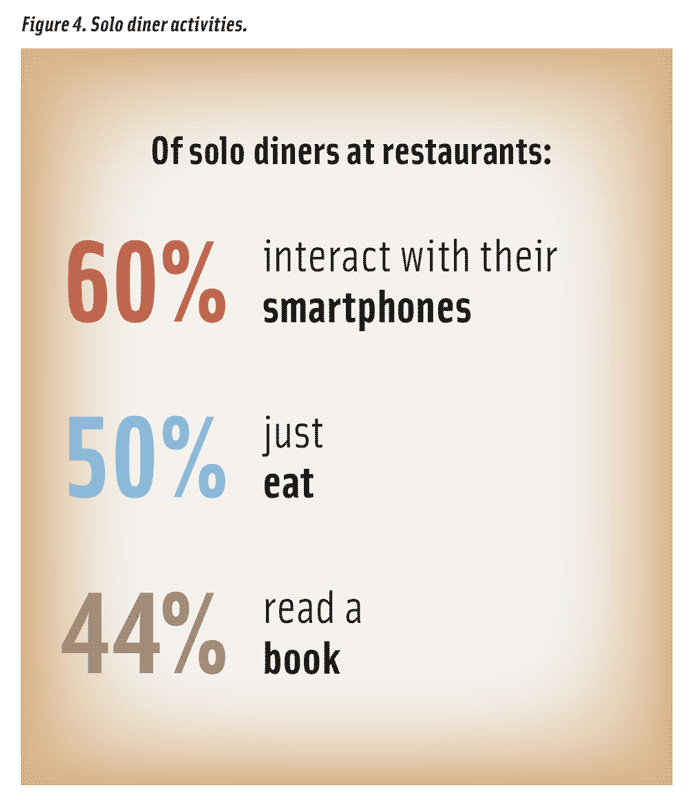 There are almost endless possibilities for ways to tap into solo diners’ technological proclivities. Consider developing games for mobile devices to entertain the solo diner, which could include live gaming with other diners and the opportunity to win discounts or free food. (Don’t forget to make the game possible to play with one hand—patrons are there to eat, after all.) Use diners’ smartphone-focus as a way to engage them more deeply with their restaurant experience, rather than letting it distract their attention.
There are almost endless possibilities for ways to tap into solo diners’ technological proclivities. Consider developing games for mobile devices to entertain the solo diner, which could include live gaming with other diners and the opportunity to win discounts or free food. (Don’t forget to make the game possible to play with one hand—patrons are there to eat, after all.) Use diners’ smartphone-focus as a way to engage them more deeply with their restaurant experience, rather than letting it distract their attention.
While the use of mobile devices is unsurprisingly common at tables for one, many people still turn to the printed word—44% of survey respondents said they read a book while dining alone. Keeping a stock of reading material available is one easy way to make such diners feel welcome. Better yet, restaurants can take advantage of their captive audience and tell them something about the food, the company philosophy, or even introduce them to who is cooking or growing the ingredients via materials or packaging that engages them with a story. Take one such example, Chipotle’s innovative “Cultivating Thought” campaign, which introduced short narratives from literary giants such as Toni Morrison and Malcolm Gladwell printed on cups and bags. While there were kinks to work out (such as the fact that no Mexican or Latino authors were represented, a significant oversight that did not go unnoticed), the campaign has garnered quite a buzz since its inauguration in June 2014.
5. Design Dishes with Solo Diners in Mind. Of course, it’s also worth considering how menu choices could better appeal to solo diners. While not universally the case, restaurant-goers are generally not looking to linger for hours over their meal when eating alone. Food that can be delivered and eaten relatively quickly should be a priority. For those reading a book or scrolling on a phone, dishes that are manageable with one hand free diners up to stay engaged with their preferred form of entertainment. Restaurants should be mindful of including finger foods or other dishes that don’t require both knife and fork on the menu. Solo diners’ menu preferences also open a wealth of creative possibilities for manufacturers in terms of meeting restaurant needs for quickly prepared and easily consumed meals.
Since diners cite a cheaper tab as one of the most significant benefits of eating out alone, restaurants interested in attracting singles should also consider offering smaller portions at lower prices, such as half plates—a trend already on the upswing in dining meccas such as New York City. And those who prefer variety, which often goes out the window when there’s no dining companion with whom to share, appreciate the option of tapas-style dining as a way to experience more than one taste during a meal. Here, too, manufacturers can offer solutions, such as ingredients portioned and packaged to accommodate small plates.
In terms of flavor profiles, the demographics that make up the solo-dining crowd have a significant penchant for spicy foods and ethnic cuisines. Keeping this in mind may be useful for restaurants and manufacturers when considering which dishes to tailor for quick preparation, ease of eating, and variable portion size.
The upshot: our study showed that solo diners are a varied group, and their preferences for seating, service, and food run the gamut. They’ll stay away if anything about their dining experience gives them flashbacks to the school cafeteria.But with some purposeful planning and ingenuity, manufacturers can provide products that more readily enable this trend, and restaurants can make themselves destinations for the growing number of people dining alone.
Marc Halperin is COO and principal, CCD Innovation, Emeryville, CA 94608 ([email protected])
